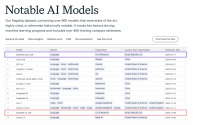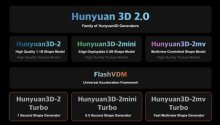Confirmation that Qwen3 training is underway!
You are using an out of date browser. It may not display this or other websites correctly.
You should upgrade or use an alternative browser.
You should upgrade or use an alternative browser.
Artificial Intelligence thread
- Thread starter 9dashline
- Start date
Baidu is a joke of a company at the moment. They should have been the Google of China. But they are the worst run tech giant in China.
They are the Google of China, they pioneered enshittification.
Ok, this is pretty useful.
LG / South Korea jumps into the competition with their own open weights reasoning model:
Claims better than R1 and QWQ 32B performance on CSAT2025, but worse performance across most of the other benchmarks. At 32B, it's still a significant achievement. Of course, it remains to be seen whether the model is of practical use or just bench marks well.
More interesting is their citation of this table:

Really goes out to show that the competition at the top end of AI really is just between two countries, with an occasional European or South Korean release trying to be relevant.
We have yet to see any competitive foundation models from any where else, including Japan, which has missed the boat on yet another major industry trend.
Claims better than R1 and QWQ 32B performance on CSAT2025, but worse performance across most of the other benchmarks. At 32B, it's still a significant achievement. Of course, it remains to be seen whether the model is of practical use or just bench marks well.
More interesting is their citation of this table:

Really goes out to show that the competition at the top end of AI really is just between two countries, with an occasional European or South Korean release trying to be relevant.
We have yet to see any competitive foundation models from any where else, including Japan, which has missed the boat on yet another major industry trend.
Tencent Hunyuan today open-sourced 5 3D generation models.
Turbo series models: Based on the 3D generation acceleration framework FlashVDM proposed by Tencent Hunyuan, the generation process can be completed within 30 seconds.
Multi-view version model: For example, Hunyuan3D-2-MV, by combining the input information of multiple views, can better capture details and generate 3D assets that meet user expectations.
Lightweight mini series models: Through model architecture optimization and operational efficiency improvement, the computing power cost can be further reduced, and its geometric model can be deployed on a 4080 graphics card or even Apple's M1 Pro chip.
In addition, the C-end page of Hunyuan 3D also supports uploading 2-4 standard perspective pictures to quickly generate high-precision, high-quality 3D models. For scenarios such as game production and 3D UGC creation, it can greatly reduce the production cost of 3D designers from multi-view original paintings to three-dimensional
models.


Turbo series models: Based on the 3D generation acceleration framework FlashVDM proposed by Tencent Hunyuan, the generation process can be completed within 30 seconds.
Multi-view version model: For example, Hunyuan3D-2-MV, by combining the input information of multiple views, can better capture details and generate 3D assets that meet user expectations.
Lightweight mini series models: Through model architecture optimization and operational efficiency improvement, the computing power cost can be further reduced, and its geometric model can be deployed on a 4080 graphics card or even Apple's M1 Pro chip.
In addition, the C-end page of Hunyuan 3D also supports uploading 2-4 standard perspective pictures to quickly generate high-precision, high-quality 3D models. For scenarios such as game production and 3D UGC creation, it can greatly reduce the production cost of 3D designers from multi-view original paintings to three-dimensional
models.


Is anyone aware why the DeepSeek search option not working for so long? It was so useful, I don't think I have seen this working for past month or more now.
If I had to guess, it's because performing search requires a search engine, and signing a commercial contract with a search provider for English is probably not particularly high on the priority list for a research company like Deep Seek.Is anyone aware why the DeepSeek search option not working for so long? It was so useful, I don't think I have seen this working for past month or more now.
Any way, now that the dust has settled a bit, a couple of observations:
- The West is still at the top of the closed weights race.
- The biggest winner in recent days, IMO, is Grok 3 from xAI. Not only is Grok 3 cheaper than any offering from Anthropic / Open AI, but it is uncensored. In my testing, xAI is really only worse than Open AI at Deep Research. In everything else, it is equal or better. Elon Musk has a winner here as long as he keeps it uncensored and accessible. This is the real "Open AI killer."
- Claude 3.7 still dominates the practical coding domain, but that's about all it really dominates. It's a specialized model for engineers and companies looking to replace engineers. It isn't particularly superior at anything else and its high price means it's only relevant for enterprises and productivity users.
- Chat GPT 4.5 was largely a bust. Few people talk about it or have found great general use cases for it. Open AI is being kept alive by Deep Research and their first mover advantage since many enterprises have originally signed with them. It's possible they'll turn it around with a new breakthrough but their pricing being as bad as it is means they're never going to be practical for the wider public.
- Google still has a monopoly on the most generous closed AI service/API, but honestly haven't improved their closed models that much since Gemini 2.0 Flash Thinking. They need to start delivering new things or risk falling behind other companies' frontier models.
- Everybody else is basically irrelevant. Censorship - not political, but general - is emerging as a challenge for Chinese closed source solutions for casual AI users, as why would you go for a Tencent or Kimi or Baidu solution, when you can just get Grok 3 that has top tier performance and is uncensored and has a relatively cheap plan?
- In the open weights landscape, the situation has gotten more diverse
- There have been almost a dozen open weights releases since Deep Seek blew the market open and raised the bar. Where previously, the industry was increasingly closing their models in imitation of Open AI and Anthropic, now there is stronger interest across the world in developing open weights models in pursuit of wide adoption.
- Deep Seek 671B is still the best over all open weights model, but is increasingly being challenged by smaller models that are better at specific tasks, particularly coding, math, and general logical reasoning.
- The advantage of smaller models like QWQ 32B, the new Mistral, Gemma 3, and Nvidia Nemotron is that they can actually be run locally - and far more cheaply than Deep Seek. This is an advantage given the market expectation of cheaper costs post-Deep Seek, and for many purposes, those smaller models perform competitively with Deep Seek.
- On the services & API side, none of the open weights companies have a great offering, but QWQ and Gemma 3 probably stand out as the most user friendly.
- Deep Seek either really dropped the ball on this one or was forced into dropping the ball by US denial of service attacks - the slow API & search still being broken a month after they said they'll fix it has cost Deep Seek's web service much interest & adoption. That's probably "okay" from Deep Seek's perspective but not great from the perspective of Chinese AI's global adoption, since Chinese closed source models are much less known and popular than Deep Seek outside of China.
Open source / open weights is the only way to get past these disadvantages, since the search capabilities can be provided by third party companies and the censorship can also be removed by those same third parties. If other Chinese AI companies haven't gotten the hint yet, this is the only path towards beating the West in market adoption under current conditions.
Last edited:
Bu
But why pay for GROK 3 when one can just use deepseek open source? One can adjust the censorship as well.If I had to guess, it's because performing search requires a search engine, and signing a commercial contract with a search provider for English is probably not particularly high on the priority list for a research company like Deep Seek.
Any way, now that the dust has settled a bit, a couple of observations:
In retrospect, Deep Seek was extremely wise to open source / open weights their model. On the AI as a service side, Chinese companies are operating at a fundamental disadvantage due to several factors: 1) the lack of a strong Chinese search engine company (due to Baidu being such a pathetic failure), which means Chinese companies have to pay Google, Bing, etc. and operate at the mercy of Western service providers, 2) the strict censorship on service based solutions, either due to Chinese laws or moral concerns, which puts them at a disadvantage vs. companies like xAI that aren't afraid to go all the way.
- The West is still at the top of the closed weights race.
- The biggest winner in recent days, IMO, is Grok 3 from xAI. Not only is Grok 3 cheaper than any offering from Anthropic / Open AI, but it is uncensored. In my testing, xAI is really only worse than Open AI at Deep Research. In everything else, it is equal or better. Elon Musk has a winner here as long as he keeps it uncensored and accessible. This is the real "Open AI killer."
- Claude 3.7 still dominates the practical coding domain, but that's about all it really dominates. It's a specialized model for engineers and companies looking to replace engineers. It isn't particularly superior at anything else and its high price means it's only relevant for enterprises and productivity users.
- Chat GPT 4.5 was largely a bust. Few people talk about it or have found great general use cases for it. Open AI is being kept alive by Deep Research and their first mover advantage since many enterprises have originally signed with them. It's possible they'll turn it around with a new breakthrough but their pricing being as bad as it is means they're never going to be practical for the wider public.
- Google still has a monopoly on the most generous closed AI service/API, but honestly haven't improved their closed models that much since Gemini 2.0 Flash Thinking. They need to start delivering new things or risk falling behind other companies' frontier models.
- Everybody else is basically irrelevant. Censorship - not political, but general - is emerging as a challenge for Chinese closed source solutions for casual AI users, as why would you go for a Tencent or Kimi or Baidu solution, when you can just get Grok 3 that has top tier performance and is uncensored and has a relatively cheap plan?
- In the open weights landscape, the situation has gotten more diverse
- There have been almost a dozen open weights releases since Deep Seek blew the market open and raised the bar. Where previously, the industry was increasingly closing their models in imitation of Open AI and Anthropic, now there is stronger interest across the world in developing open weights models in pursuit of wide adoption.
- Deep Seek 671B is still the best over all open weights model, but is increasingly being challenged by smaller models that are better at specific tasks, particularly coding, math, and general logical reasoning.
- The advantage of smaller models like QWQ 32B, the new Mistral, Gemma 3, and Nvidia Nemotron is that they can actually be run locally - and far more cheaply than Deep Seek. This is an advantage given the market expectation of cheaper costs post-Deep Seek, and for many purposes, those smaller models perform competitively with Deep Seek.
- On the services & API side, none of the open weights companies have a great offering, but QWQ and Gemma 3 probably stand out as the most user friendly.
- Deep Seek either really dropped the ball on this one or was forced into dropping the ball by US denial of service attacks - the slow API & search still being broken a month after they said they'll fix it has cost Deep Seek's web service much interest & adoption. That's probably "okay" from Deep Seek's perspective but not great from the perspective of Chinese AI's global adoption, since Chinese closed source models are much less known and popular than Deep Seek outside of China.
Open source / open weights is the only way to get past these disadvantages, since the search capabilities can be provided by third party companies and the censorship can also be removed by those same third parties. If other Chinese AI companies haven't gotten the hint yet, this is the only path towards beating the West in market adoption under current conditions.

